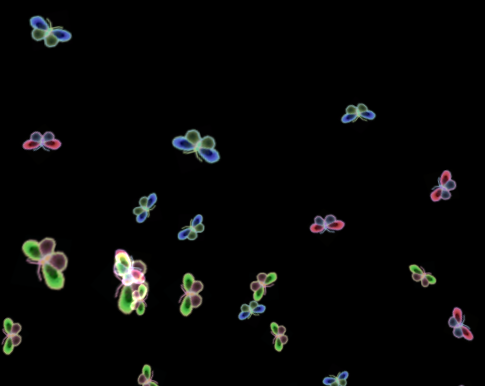-
简介
这节课NeHe教我们怎样把图片作为资源嵌入到exe可执行文件中,这样当我们发布程序的时候就可以不需要附带上图片文件了。由于这部分的内容和OSG并没有关系,主要是使用Windows编程中资源的概念,我对这部分并不是很熟悉,因此本课只实现最后的效果。图片并未处理成NeHe中的这种方式。
-
实现
首先创建我们需要的50只蝴蝶的模型,并且加载需要的纹理
void initialize()
{
for (int loop=0; loop<50; loop++)
{
setObject(loop);
}
g_Tex1 = new osg::Texture2D;
g_Tex1->setFilter(osg::Texture::MAG_FILTER, osg::Texture::LINEAR);
g_Tex1->setFilter(osg::Texture::MAG_FILTER, osg::Texture::LINEAR);
g_Tex1->setImage(osgDB::readImageFile("Data/Butterfly1.bmp"));
g_Tex2 = new osg::Texture2D;
g_Tex2->setFilter(osg::Texture::MAG_FILTER, osg::Texture::LINEAR);
g_Tex2->setFilter(osg::Texture::MAG_FILTER, osg::Texture::LINEAR);
g_Tex2->setImage(osgDB::readImageFile("Data/Butterfly2.bmp"));
g_Tex3 = new osg::Texture2D;
g_Tex3->setFilter(osg::Texture::MAG_FILTER, osg::Texture::LINEAR);
g_Tex3->setFilter(osg::Texture::MAG_FILTER, osg::Texture::LINEAR);
g_Tex3->setImage(osgDB::readImageFile("Data/Butterfly3.bmp"));
}osg::Group* createButterflyGroup()class ButterFlyGroupCallback : public osg::NodeCallbackclass TranslateUpdateCallback : public osg::NodeCallback将所有这些部分添加到场景根节点下,编译运行程序:
附:本课源码(源码中可能存在错误和不足,仅供参考)
#include "../osgNeHe.h"
#include <QtCore/QTimer>
#include <QtGui/QApplication>
#include <QtGui/QVBoxLayout>
#include <osgViewer/Viewer>
#include <osgDB/ReadFile>
#include <osgQt/GraphicsWindowQt>
#include <osg/MatrixTransform>
#include <osg/PolygonMode>
#include <osg/Texture2D>
#include <osg/BlendFunc>
osg::Texture2D *g_Tex1, *g_Tex2, *g_Tex3;
struct object
{
int tex;
float x;
float y;
float z;
float yi;
float spinz;
float spinzi;
float flap;
float fi;
};
object obj[50];
void setObject(int loop)
{
obj[loop].tex=rand()%3;
obj[loop].x=rand()%34-17.0f;
obj[loop].y=18.0f;
obj[loop].z=-((rand()%30000/1000.0f)+10.0f);
obj[loop].spinzi=(rand()%10000)/5000.0f-1.0f;
obj[loop].flap=0.0f;
obj[loop].fi=0.05f+(rand()%100)/1000.0f;
obj[loop].yi=0.001f+(rand()%1000)/10000.0f;
}
void initialize()
{
for (int loop=0; loop<50; loop++)
{
setObject(loop);
}
g_Tex1 = new osg::Texture2D;
g_Tex1->setFilter(osg::Texture::MAG_FILTER, osg::Texture::LINEAR);
g_Tex1->setFilter(osg::Texture::MAG_FILTER, osg::Texture::LINEAR);
g_Tex1->setImage(osgDB::readImageFile("Data/Butterfly1.bmp"));
g_Tex2 = new osg::Texture2D;
g_Tex2->setFilter(osg::Texture::MAG_FILTER, osg::Texture::LINEAR);
g_Tex2->setFilter(osg::Texture::MAG_FILTER, osg::Texture::LINEAR);
g_Tex2->setImage(osgDB::readImageFile("Data/Butterfly2.bmp"));
g_Tex3 = new osg::Texture2D;
g_Tex3->setFilter(osg::Texture::MAG_FILTER, osg::Texture::LINEAR);
g_Tex3->setFilter(osg::Texture::MAG_FILTER, osg::Texture::LINEAR);
g_Tex3->setImage(osgDB::readImageFile("Data/Butterfly3.bmp"));
}
class ButterflyUpdateCallback : public osg::Drawable::UpdateCallback
{
public:
ButterflyUpdateCallback(int index, int texIndex) : _index(index), _texIndex(texIndex)
{
//NOP
}
virtual void update(osg::NodeVisitor*, osg::Drawable* drawable)
{
osg::Geometry *geometry = dynamic_cast<osg::Geometry*>(drawable);
if(!geometry)
return;
osg::Vec3Array *vertexArray = dynamic_cast<osg::Vec3Array*>(geometry->getVertexArray());
if (!vertexArray)
return;
vertexArray->clear();
vertexArray->push_back(osg::Vec3(1.0f, 1.0f, 0.0f));
vertexArray->push_back(osg::Vec3(-1.0f, 1.0f, obj[_index].flap));
vertexArray->push_back(osg::Vec3(-1.0f,-1.0f, 0.0f));
vertexArray->push_back(osg::Vec3(1.0f, 1.0f, 0.0f));
vertexArray->push_back(osg::Vec3(-1.0f,-1.0f, 0.0f));
vertexArray->push_back(osg::Vec3(1.0f,-1.0f, obj[_index].flap));
vertexArray->dirty();
geometry->setVertexArray(vertexArray);
if (!geometry->getOrCreateStateSet()->getTextureAttribute(0, osg::StateAttribute::TEXTURE))
{
if (_texIndex == 0 )
{
geometry->getOrCreateStateSet()->setTextureAttributeAndModes(0, g_Tex1);
}
if (_texIndex == 1)
{
geometry->getOrCreateStateSet()->setTextureAttributeAndModes(0, g_Tex2);
}
if (_texIndex == 2)
{
geometry->getOrCreateStateSet()->setTextureAttributeAndModes(0, g_Tex3);
}
}
}
int _index;
int _texIndex;
};
class RotateUpdateCallback : public osg::NodeCallback
{
public:
RotateUpdateCallback(int index) : _index(index){ }
virtual void operator()(osg::Node* node, osg::NodeVisitor* nv)
{
osg::MatrixTransform *mt = dynamic_cast<osg::MatrixTransform*>(node);
if (!mt)
return;
mt->setMatrix(osg::Matrix::rotate(osg::DegreesToRadians(obj[_index].spinz), osg::Z_AXIS));
traverse(node, nv);
}
int _index;
};
class TranslateUpdateCallback : public osg::NodeCallback
{
public:
TranslateUpdateCallback(int index) : _index(index){}
virtual void operator()(osg::Node* node, osg::NodeVisitor* nv)
{
osg::MatrixTransform *mt = dynamic_cast<osg::MatrixTransform*>(node);
if (!mt)
return;
mt->setMatrix(osg::Matrix::translate(obj[_index].x,obj[_index].y,obj[_index].z));
traverse(node, nv);
}
int _index;
};
class ButterFlyGroupCallback : public osg::NodeCallback
{
public:
ButterFlyGroupCallback(){}
virtual void operator()(osg::Node* node, osg::NodeVisitor* nv)
{
for (int loop = 0; loop < 50; ++loop)
{
obj[loop].y-=obj[loop].yi;
obj[loop].spinz+=obj[loop].spinzi;
obj[loop].flap+=obj[loop].fi;
if (obj[loop].y<-18.0f)
{
setObject(loop);
}
if ((obj[loop].flap>1.0f) || (obj[loop].flap<-1.0f))
{
obj[loop].fi=-obj[loop].fi;
}
}
traverse(node, nv);
}
};
osg::Group* createButterflyGroup()
{
osg::Group *butterflyGroup = new osg::Group;
butterflyGroup->addUpdateCallback(new ButterFlyGroupCallback);
for (int loop = 0; loop < 50; ++loop)
{
osg::MatrixTransform *zoomMT = new osg::MatrixTransform;
zoomMT->setMatrix(osg::Matrix::translate(obj[loop].x,obj[loop].y,obj[loop].z));
zoomMT->addUpdateCallback(new TranslateUpdateCallback(loop));
osg::MatrixTransform *rotateX = new osg::MatrixTransform;
rotateX->setMatrix(osg::Matrix::rotate(osg::DegreesToRadians(45.0), osg::X_AXIS));
osg::MatrixTransform *rotateZ = new osg::MatrixTransform;
rotateZ->setMatrix(osg::Matrix::rotate(osg::DegreesToRadians(obj[loop].spinz), osg::Z_AXIS));
rotateZ->addUpdateCallback(new RotateUpdateCallback(loop));
osg::Geode *butterflyGeode = new osg::Geode;
osg::Geometry *butterGeometry = new osg::Geometry;
butterGeometry->setUpdateCallback(new ButterflyUpdateCallback(loop, obj[loop].tex));
osg::Vec3Array *vertexArray = new osg::Vec3Array;
osg::Vec2Array *texArray = new osg::Vec2Array;
vertexArray->push_back(osg::Vec3(1.0f, 1.0f, 0.0f));
vertexArray->push_back(osg::Vec3(-1.0f, 1.0f, obj[loop].flap));
vertexArray->push_back(osg::Vec3(-1.0f,-1.0f, 0.0f));
vertexArray->push_back(osg::Vec3(1.0f, 1.0f, 0.0f));
vertexArray->push_back(osg::Vec3(-1.0f,-1.0f, 0.0f));
vertexArray->push_back(osg::Vec3(1.0f,-1.0f, obj[loop].flap));
texArray->push_back(osg::Vec2(1.0f,1.0f));
texArray->push_back(osg::Vec2(0.0f,1.0f));
texArray->push_back(osg::Vec2(0.0f,0.0f));
texArray->push_back(osg::Vec2(1.0f,1.0f));
texArray->push_back(osg::Vec2(0.0f, 0.0f));
texArray->push_back(osg::Vec2(1.0f,0.0f));
butterGeometry->setVertexArray(vertexArray);
butterGeometry->addPrimitiveSet(new osg::DrawArrays(osg::PrimitiveSet::TRIANGLES, 0, vertexArray->size()));
butterGeometry->setTexCoordArray(0, texArray, osg::Array::BIND_PER_VERTEX);
butterGeometry->getOrCreateStateSet()->setMode(GL_LIGHTING, false);
osg::BlendFunc *blendFunc = new osg::BlendFunc(osg::BlendFunc::ONE, osg::BlendFunc::SRC_ALPHA);
butterGeometry->getOrCreateStateSet()->setAttributeAndModes(blendFunc);
butterGeometry->getOrCreateStateSet()->setMode(GL_DEPTH_TEST, false);
butterflyGeode->addDrawable(butterGeometry);
butterflyGroup->addChild(zoomMT);
zoomMT->addChild(rotateX);
rotateX->addChild(rotateZ);
rotateZ->addChild(butterflyGeode);
}
return butterflyGroup;
}
class ViewerWidget : public QWidget, public osgViewer::Viewer
{
public:
ViewerWidget(osg::Node *scene = NULL)
{
QWidget* renderWidget = getRenderWidget( createGraphicsWindow(0,0,640,480), scene);
QVBoxLayout* layout = new QVBoxLayout;
layout->addWidget(renderWidget);
layout->setContentsMargins(0, 0, 0, 1);
setLayout( layout );
connect( &_timer, SIGNAL(timeout()), this, SLOT(update()) );
_timer.start( 10 );
}
QWidget* getRenderWidget( osgQt::GraphicsWindowQt* gw, osg::Node* scene )
{
osg::Camera* camera = this->getCamera();
camera->setGraphicsContext( gw );
const osg::GraphicsContext::Traits* traits = gw->getTraits();
camera->setClearColor( osg::Vec4(0.0, 0.0, 0.0, 0.5) );
camera->setViewport( new osg::Viewport(0, 0, traits->width, traits->height) );
camera->setProjectionMatrixAsPerspective(45.0f, static_cast<double>(traits->width)/static_cast<double>(traits->height), 0.1f, 100.0f );
camera->setViewMatrixAsLookAt(osg::Vec3d(0.0f, 25.0f, -45.0f), osg::Vec3d(0, 0, 0), osg::Vec3d(0, 1, 0));
this->setSceneData( scene );
return gw->getGLWidget();
}
osgQt::GraphicsWindowQt* createGraphicsWindow( int x, int y, int w, int h, const std::string& name="", bool windowDecoration=false )
{
osg::DisplaySettings* ds = osg::DisplaySettings::instance().get();
osg::ref_ptr<osg::GraphicsContext::Traits> traits = new osg::GraphicsContext::Traits;
traits->windowName = name;
traits->windowDecoration = windowDecoration;
traits->x = x;
traits->y = y;
traits->width = w;
traits->height = h;
traits->doubleBuffer = true;
traits->alpha = ds->getMinimumNumAlphaBits();
traits->stencil = ds->getMinimumNumStencilBits();
traits->sampleBuffers = ds->getMultiSamples();
traits->samples = ds->getNumMultiSamples();
return new osgQt::GraphicsWindowQt(traits.get());
}
virtual void paintEvent( QPaintEvent* event )
{
frame();
}
protected:
QTimer _timer;
};
osg::Node* buildScene()
{
initialize();
osg::Group *root = new osg::Group;
root->addChild(createButterflyGroup());
return root;
}
int main( int argc, char** argv )
{
QApplication app(argc, argv);
ViewerWidget* viewWidget = new ViewerWidget(buildScene());
viewWidget->setGeometry( 100, 100, 640, 480 );
viewWidget->show();
return app.exec();
}
























 1万+
1万+











 被折叠的 条评论
为什么被折叠?
被折叠的 条评论
为什么被折叠?








